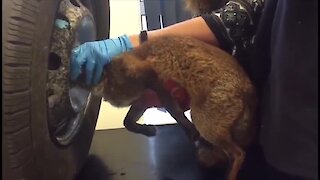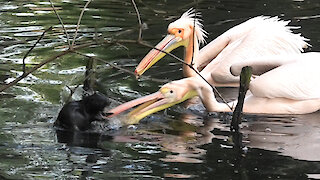Premium Only Content

De-ticking an angry rescued lion is scary business
Ticks can be very dangerous, transmitting diseases, so it's very important to keep them away from animals who have to live in captivity. This rescued lion, however, has had a tough life, sharing a small enclosure with many other males, so even though he has been rescued, he is still a very cranky individual, and is not having any of it! Would you have the courage to de-tick an angry lion?
The lion (Panthera leo) is one of the five species of big cats belonging to the Panthera genus, along with the tiger (Panthera tigris), the leopard (Panthera pardus), the jaguar (Panthera onca), and the Snow Leopard (Panthera uncia).
Lions are found in most sub-Saharan countries in Africa, but originally their range used to be much wider, from Northern Africa through Southwest Asia, east into India, and west into Europe.
Lions are found in most African habitats, being only absent from the interior of the Sahara desert and tropical rainforest. When there is not water available for them to drink, they get moisture from their prey, and sometimes even plants, which allows them to live in very arid environments.
Lions are the most social of all cat species, and related females and their cubs live together in groups called prides, and males form coalitions.
The lion is the second largest cat species in the world, being only smaller than the tiger.
The most characteristic feature of lions is the males' prominent mane, which goes from light buff to silvery grey, yellowish red and dark brown. It is the only cat species with an obvious sexual dimorphism. The cubs have spots which mostly fade as they grow older.
-
 0:43
0:43
NataliaCara
2 years agoIt's dinner time for this rescued immature Southern Elephant Seal
3881 -
 0:38
0:38
ViralHog
5 years ago $0.92 earnedTwo Rescued Animals Have a Moment
4.57K -
 2:25
2:25
ViralHog
5 years ago $8.38 earnedRescued Baby Bats Try New Fruit
13.8K1 -
 3:30
3:30
ViralHog
5 years ago $0.20 earnedRescued Pig and Macaque Enjoy Life
1.59K -
 0:41
0:41
ViralHog
5 years agoRescued Ringtail Possum Curls up to Warmth
165 -
 1:20
1:20
rumblestaff
5 years agoFox rescued after getting stuck inside tire
4.15K1 -
 1:27
1:27
SloggerVlogger
5 years agoAngry pelicans chase away intrusive rodent
2.62K2 -
 0:59
0:59
Magicscience
5 years ago $13.29 earnedButterfly takes a drink after being rescued from certain death
34.3K -
 1:36
1:36
SWNS
6 years agoMountain lion cubs are lucky to be alive after they were rescued after their mum was killed
272 -
 1:02
1:02
ViralHog
6 years ago $61.89 earnedLion Family Feud
92.2K1